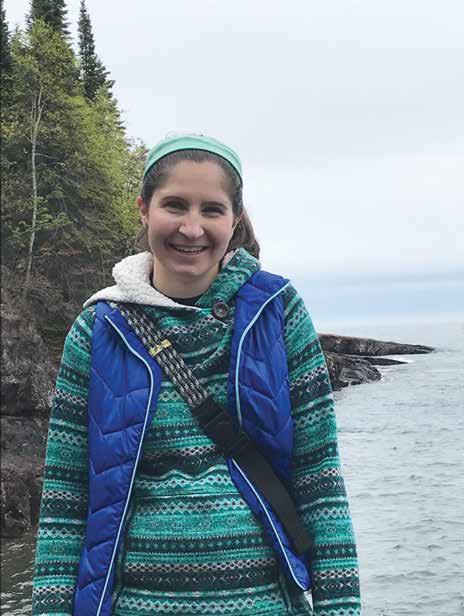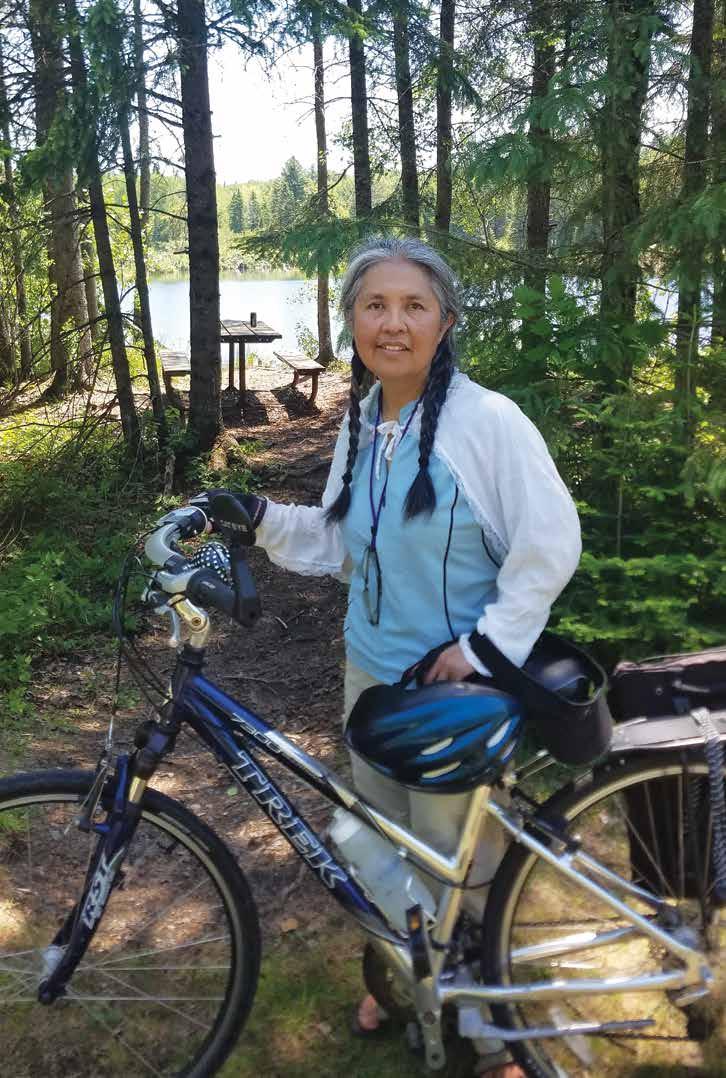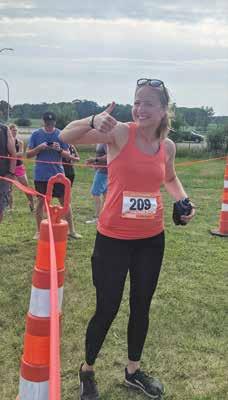
4 minute read
World Day: November 14 DIABETES
By Molly Ovenden
The summer between sophomore and junior years in college marked when 27-year-old Duluth resident Jena Benoit’s life changed.
With a middle school POTS diagnosis (postural orthostatic tachycardia syndrome), symptoms of feeling faint or dizzy, low blood pressure and high heart rate were common. Her doctor anticipated she’d grow out of POTS, but they ran tests for blood glucose. But more tests revealed Type 1 diabetes.
Overwhelmed at 20 years old, she said, “I remember being in the car afterwards just being in tears.”
Thirty-six-year-old Superior resident Megan Wilson’s parents were concerned when she’d been losing weight, drinking extra water and urinating excessively, so she went to the doctor the day before second grade.
Jena Benoit loves hiking and biking by Lake Superior. She likes cooking and baking sweets as well as doing crafts, from card making to home decor wreath making.
“Life completely changed,” Wilson said, with her Type 1 diabetes diagnosis.
A steep learning curve
Checking blood sugar, insulin injections and counting carbs were new concepts.
“I definitely had a fear of needles before the diagnosis,” Benoit said.
“It stinks to be a diabetic and terrified of needles,” Wilson said.
Wilson’s mom and teacher helped give injections.
At 10, Wilson attended Camp Needlepoint, returning annually until age 16, and then as a staff member for seven more years.
“For the first time in my life it was normal to have diabetes,” Wilson said. She even gave herself a shot for the first time at camp.
Ani Othman’s continued love of geography and travel pairs well with her nursing and diabetes educator roles. Here she's in Cameroon, Africa, doing diabetes education and staff training.
fully embraced the Northland lifestyle, so different from where she was

Daily challenges
It’s hard “how unpredictable it can be,” Benoit said.
Everything impacts diabetes. Sometimes exercise or stress raises blood sugar.
“It’s kind of an invisible disease,” Wilson said.
“Honestly, I would say nothing is easy. It’s there 24/7. I’m constantly thinking about what’s going on.”
“Everything needs to be planned out around my blood sugar … (and it’s) harder to be spontaneous,” Benoit said.
Tools like an insulin pump and a continuous glucose monitor (CGM) make life easier.
A CGM measures real-time glucose levels. It takes 60-90 minutes for insulin to take effect. The monitor shows active insulin levels in their system.
Finding clothes that can stow her pump is tricky, too. She’s strategic when mountain biking. It’s flown off before.

Benoit also loves cycling, enjoying the American Diabetes Association’s Tour de Cure bike rides. Events like JDRFOne Walk are empowering, too.
Choosing to thrive
“I feel like you have to make it fun. There’s not much that’s fun about diabetes,” Benoit said.
She celebrates her successful life while living with diabetes every year on her diagnosis day.
Wilson celebrates annually, too, marking “the accomplishment of living another year,” she said.
“You can’t do it alone,” Benoit said.
Friendships with other Type 1 diabetics have been crucial. Wilson still connects with Camp Needlepoint friends, as well as with diabetic athletes through social media.
Wilson jokes about her CGM or insulin pump, “It’s my robot superpowers.”
Words of encouragement for newly diagnosed
It’s helpful when friends are aware of the signs of high and low blood sugar.
Wilson recommends having friends ask “‘Hey, how can I best support you?’”
“It’s possible to live your life to the fullest and do all the things you want to do (with diabetes) even when it doesn’t seem like that in the beginning,” Benoit said.
“Don’t let diabetes stop you from doing anything you really want to do. It’s worth the challenge. … It’s OK to not be OK, to hate the disease, to express how you feel when things aren’t going how they should,” Wilson said.
Diabetes professional
For Duluth resident Ani Othman, 59, diabetes is a constant thought for her, too. She’s an RN diabetes educator at Essentia Health. Born on the other side of the world, Othman left Malaysia in 1985.
Othman studied in the medical track in Malaysia with biology, math and education, but she loved geography.
“I want to go somewhere famous in terms of geography,” Othman said.
From a hot country, she’s curious about the weather and wanted to see snow. Having learned about the Great Lakes, she looked in Minnesota.
“I came straight to Duluth to go to UMD,” Othman said.
After decades of Minnesota winters, she still enjoys looking at snowflakes.
Initially she couldn’t find work in biology or geography fields, so she returned to school for nursing.
Skills from various degrees came full circle. Using biology to understand the human body, how it has a geography of its own, Othman explains what’s happening in a patient's body and how diet and activity impacts them.
Megan Wilson poses at a running race with her classic big smile, ready to hit the ground running.

Cultural differences
In 1990, Othman married native Minnesotan Bob Flagler. Having experienced American student life and culture, she realized with Flagler that there was even more American culture, and she continues learning nuances of language or culture.
Many people still think American roads are “paved with gold,” Othman said.
It’s true for her. With job shortages in Malaysia, America continually provides opportunities to study and work. Cultural curiosity and love of learning made her stay in Minnesota.
Life today
“I think as I get older, I’m more mindful,” she said, proudly anticipating her 60th birthday.
Elders are respected in Malaysian culture.
She remains humble, too, as new cultural lingo pops up in daily conversation.

Pronunciation is different between English and Malay alphabets.
She said, “I give people permission … (to ask) me to slow down. I have an accent. I’m not a native speaker.” D
Types of Diabetes
• Type 2: The most common type when the body’s improper insulin use means some people manage blood sugar levels with healthy eating and exercise. Others need medication or insulin.
• Type 1: Often found in children or adults under age 30. The pancreas doesn’t produce insulin. The body converts consumed carbohydrates into blood sugar (blood glucose) for energy. Insulin transports glucose from the bloodstream to body cells, so insulin therapy helps.
• Gestational Diabetes: During pregnancy, the body’s unable to produce or process insulin, causing high blood sugar, and usually disappears after birth.
• Secondary Diabetes: This rare form, results from a genetic disorder, disease, medication side effects or pancreatic surgery.
Support Resources
• The Association of Diabetes Care and Education Specialists
• Juvenile Diabetes Research Foundation
• Diabetes Public Health Resources (Center for Disease Control)
• American Diabetes Association










